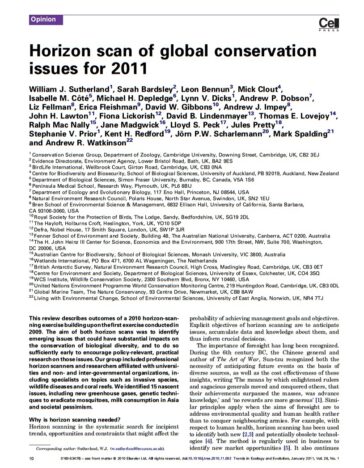
Horizon scan of global conservation issues for 2011
-
Species
This review describes outcomes of a 2010 horizon-scanning exercise building upon the first exercise conducted in 2009. The aim of both horizon scans was to identify emerging issues that could have substantial impacts on the conservation of biological diversity, and to do so sufficiently early to encourage policy-relevant, practical research on those issues.
Our group included professional horizon scanners and researchers affiliated with universities and non- and inter-governmental organizations, including specialists on topics such as invasive species, wildlife diseases and coral reefs. We identified 15 nascent issues, including new greenhouse gases, genetic techniques to eradicate mosquitoes, milk consumption in Asia and societal pessimism.
Author(s): William J. Sutherland1, Sarah Bardsley2, Leon Bennun, Mick Clout4, Isabelle M. Cote5, Michael H. Depledge6, Lynn V. Dicks1, Andrew P. Dobson7, Liz Fellman8, Erica Fleishman9, David W. Gibbons10, Andrew J. Impey8, John H. Lawton11, Fiona Lickorish12, David B. Lindenmayer13, Thomas E. Lovejoy14, Ralph Mac Nally15, Jane Madgwick16, Lloyd S. Peck17, Jules Pretty18, Stephanie V. Prior1, Kent H. Redford19, Jorn P.W. Scharlemann20, Mark Spalding21 and Andrew R. Watkinson22
Author notes:
1 Conservation Science Group, Department of Zoology, Cambridge University, Downing Street, Cambridge, UK, CB2 3EJ
2 Evidence Directorate, Environment Agency, Lower Bristol Road, Bath, UK, BA2 9ES
3 BirdLife International, Wellbrook Court, Girton Road, Cambridge, UK, CB3 0NA
4 Centre for Biodiversity and Biosecurity, School of Biological Sciences, University of Auckland, PB 92019, Auckland, New Zealand
5 Department of Biological Sciences, Simon Fraser University, Burnaby, BC, Canada, V5A 1S6
6 Peninsula Medical School, Research Way, Plymouth, UK, PL6 8BU
7 Department of Ecology and Evolutionary Biology, 117 Eno Hall, Princeton, NJ 08544, USA
8 Natural Environment Research Council, Polaris House, North Star Avenue, Swindon, UK, SN2 1EU
9 Bren School of Environmental Science & Management, 6832 Ellison Hall, University of California, Santa Barbara,
CA 93106-3060, USA
10 Royal Society for the Protection of Birds, The Lodge, Sandy, Bedfordshire, UK, SG19 2DL
11 The Hayloft, Holburns Croft, Heslington, York, UK, YO10 5DP
12 Defra, Nobel House, 17 Smith Square, London, UK, SW1P 3JR
13 Fenner School of Environment and Society, Building 48, The Australian National University, Canberra, ACT 0200, Australia
14 The H. John Heinz III Center for Science, Economics and the Environment, 900 17th Street, NW, Suite 700, Washington,
DC 20006, USA
15 Australian Centre for Biodiversity, School of Biological Sciences, Monash University, VIC 3800, Australia
16 Wetlands International, PO Box 471, 6700 AL Wageningen, The Netherlands
17 British Antarctic Survey, Natural Environment Research Council, High Cross, Madingley Road, Cambridge, UK, CB3 0ET
18 Centre for Environment and Society, Department of Biological Sciences, University of Essex, Colchester, UK, CO4 3SQ
19WCS Institute, Wildlife Conservation Society, 2300 Southern Blvd, Bronx, NY 10460, USA
20United Nations Environment Programme World Conservation Monitoring Centre, 219 Huntingdon Road, Cambridge, UK, CB3 0DL
21 Global Marine Team, The Nature Conservancy, 93 Centre Drive, Newmarket, UK, CB8 8AW
22 Living with Environmental Change, School of Environmental Sciences, University of East Anglia, Norwich, UK, NR4 7TJ

